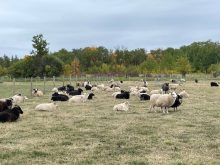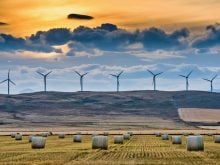In everyday conversation involving agriculture, we hear about poor soils, clay soils, good soils, ruined soils, eroded soils, degraded soils, sandy soils, silty soils and so on. These names or descriptions are, for the most part, meaningless and very subjective.
Soil is, in reality, a storehouse of water, mineral compounds of multiple complexities and plant-essential mineral nutrients, erroneously called plant food. Agricultural soils may vary from virtual deserts to swamps and peat bogs.
We usually categorize cropland into sandy soils, clay soils and silt soils.
Read Also

Claas brings 1000 Series SP forage harvesters to Canada
In mid-August, Claas unveiled its new line of Jaguar forage harvesters at an event in Visalia, California, deep in the heart of that state’s dairy region.
When we refer to sandy soils, sand is really just broken-down pieces of mineral rocks from pinhead size and finer. Sandy soils are easy to dig but poor for holding water and soluble plant nutrients. One foot of sand will hold about 1.5 inches of water at capacity, with about 0.7 inches plant available.
Clay soils are ultra-fine particles of rock, and are often so small they can be suspended in water. When clay soils dry out, they become hard and compacted but they hold water very well, up to four to five inches per linear foot with two to 2.5 inches available for plant growth.
Silt soils are ground, rounded rock particles of intermediate size between sand and clay. These soils are formed on river bottoms where the finer clay particles are washed away. These soils can hold three to four inches of water per linear foot with up to two inches becoming plant available.
Soils can range from sandy to clay types, since they may contain larger amounts of sand, silt or clay. Good soils or loamy soils are ones that contain equal parts of sand, silt and clay. Unfortunately, this ideal mix is not that common. Typically on the Prairies, we may have soils that are 80 per cent sand or 80 per cent clay types.
Soil zones
Soil zones on the Prairies are grouped according to colour, depth or solonetzic types. Types of soils range from Black to Brown to Gray-coloured soils. The pH of Prairie soils varies from 3.5 to 8.5 or higher. Most agricultural soils have a pH between 5 and 8. From 10 to 30 per cent of soils in each Prairie province are on the acidic side with a pH of 5 to 6. Alberta has the most acidic soils in the Prairies.
Surprisingly, a cubic foot of sandy soil will weigh more than a cubic foot of clay soil. Peat soils, of course, will weigh a lot less when they are dry.
Of prime importance for all soils is the organic content present. This organic content varies between one and 10 per cent, not including peat-based soils, and is the major storage for plant nutrients, particularly nitrogen, phosphorus and sulphur.
Descriptions and classifications of Canadian soils in general go into far more detail than you need to understand. What you must understand is how well the cropland produces grain crops and what the moisture and seasonal limitations are.
In an article on soil fertility, it’s pointed out that an acre of soil to six inches in depth weighs two million pounds. So, it is simple math. If you add two pounds of actual zinc per acre, you will end up with an extra one part per million (one ppm) in your cropland.
Soil moisture
Have you noticed when you grow wheat or barley, if your growing-season moisture is good the bulk of the cereal roots will remain in the top six to eight inches (15 to 20 centimetres), which contain the highest level of plant nutrients? In dry growing seasons, or naturally dry areas, cereal roots will move down to three feet or more (90 centimetres).
Do your own digging, which is much easier on sandy soil. Soil moisture deep in the soil profile will move up the soil profile from nine feet or more (2.7 metres). The moisture moves up as vapour as long as the surface soil is drier. Therefore, cereals, like most other crops, do not need taproots to access deep soil moisture. Have you ever seen taproots on an uprooted spruce tree?
Actual soil composition, generalized averages
Take a cubic foot of soil from your cropland. What is it made of?
First of all, 50 per cent of the volume, clay or sand, is air when dry and water when waterlogged (saturated). Remember, crop plants cannot grow in this waterlogged soil — it has to drain first. The mineral component of this soil is 50 per cent by weight oxygen. Yes, oxygen, in the form of oxides.
In terms of iron oxides, silicon dioxides, aluminum oxides, etc., 25 per cent, on average, of typical soil is silicon, seven per cent is aluminum and five per cent is iron. Thus, 87 per cent of an average soil, sand, clay or silt is made up of these four elements. The other 13 per cent of your average soil primarily consists of potassium, phosphorus, calcium (one to 10 per cent or more), magnesium and trace elements such as zinc, copper, boron, molybdenum, manganese, chlorine, nickel and cobalt.
Trace elements also in the soil and required by animals are selenium, fluorine, iodine, sodium, tin and chromium. What some non-farming people do not realize is when we get to parts per million or parts per billion, all soils contain lead, antimony, arsenic, mercury, gold, silver, cadmium and so on. All of these elements, toxic or otherwise, exist at trace levels in sea water but are generally considered to be below harmful levels.
How’s my cropland soil?
The first limitation to your cropland soil is water, or the expected annual precipitation. The second factor is the growing degree days, which varies from southern Manitoba at 2,300 heat units to often 1,900 or less for Alberta and British Columbia’s Peace Region. Corn and soybeans do well at heat units higher than 2,200 but poorly below 2,000 units.
Your crop production guide for your cropland should be based on the better crop yields grown by your near neighbours. What’s the average in your farming area over the last five years or so? If you intend buying, leasing or renting new cropland, these are the basic factors you must consider before you soil test any new farmland. Soil testing will tell you what’s there and the neighbours’ yields and crop types will tell you how much and what yields you can expect to attain.
There are no miracles in nature. Do not waste time trying to “make a silk purse out of a sow’s ear.” Many farmers waste time trying to grow grain crops on saline or frequently flooded soil when they should return it to saline- or flood-tolerant grasses and take off the occasional hay crop or use it as a pasture.
To speak plainly, the soil on your cropland is your nutrient reserve, dependant on annual rainfall, normal heat units and supplemental fertilizer to grow your target crop yield. A soil test will indicate how much macro and micronutrients you must apply to any given crop to obtain that target yield within the constraints of your growing season location, heat units expected and your annual anticipated rainfall.
Pest issues can and will interfere with crop yield and quality expectations but forewarned is forearmed. Keep ahead of problems and, remember, pest prevention is much cheaper than pest control, whether weed, insect or fungal, or any other crop-damaging situation.















